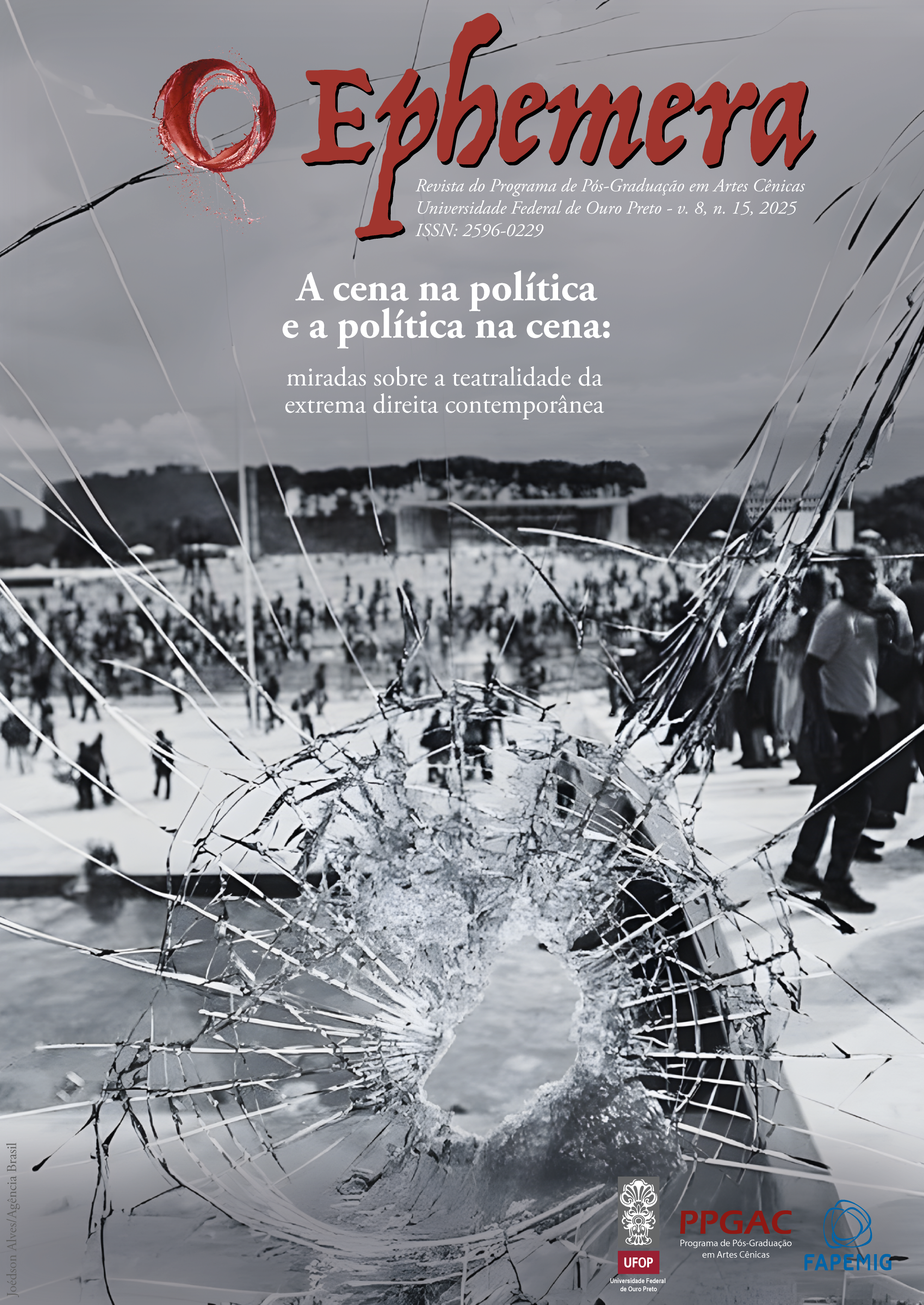O olhar de Antígona através dos tempos
Tragédia, de Quatroloscinco Teatro do Comum
Resumo
Ao longo de mais de dois mil e quinhentos anos, a personagem trágica Antígona nos lança o seu olhar sobre as leis positivas dos homens e sobre o direito fundamental de enterrar o cadáver de seu irmão. Cada nova aparição da personagem traz questionamentos sobre o seu papel e a sua insistência política frente ao contexto em que é reencenada. Este artigo apresenta uma leitura crítica da dramaturgia da peça Tragédia, de Quatroloscinco (2019), a partir sobretudo da teoria de Georges Didi-Huberman acerca da imagem crítica, com o objetivo de analisar de que forma o grupo relê essa personagem clássica e se insere em uma linhagem de reescritas do mito, relacionando-o ao contexto político do país. Para isso, propomos quatro questões centrais sobre a personagem na peça: de onde vem esse olhar de Antígona? O que ela observa? O que ela nos diz? A que nos leva esse olhar? A conclusão desta análise é de que o grupo, dessa forma, convoca o público a questionar o olhar e seus pontos de vista sobre o contexto político atual no Brasil, apresentando uma Antígona que insiste em aparecer, apesar de tantas vezes morta.
Downloads
Referências
BENEVENUTO, Assis; COLETTA, Marcos. Tragédia. Belo Horizonte: Javali, 2020.
BENJAMIN, Walter. Origem do drama trágico alemão. Belo Horizonte: Autêntica, 2013.
DIDI-HUBERMAN, Georges. Diante do tempo: história da arte e anacronismo das imagens. Belo Horizonte: Ed. UFMG, 2015.
DIDI-HUBERMAN, Georges. O que vemos, o que nos olha. São Paulo: ed. 34, 2010.
DIDI-HUBERMAN, Georges. Quando as imagens tomam posição. Belo Horizonte: Ed. UFMG, 2017.
FRAISSE, Simone. Antigone. In: BRUNEL, Pierre. Diccionnaire des mythes littéraires. Paris : Éditions du Rocher, 1988.
GUIMARÃES, Júlia; ACÁCIO, Leandro Silva. Entrevista com Josette Féral - Professora e pesquisadora teatral. Urdimento - Revista de Estudos em Artes Cênicas, Florianópolis, v. 1, n. 16, p. 179–185, 2011. DOI: 10.5965/1414573101162011179. Disponível em: https://www.revistas.udesc.br/index.php/urdimento/article/view/1414573101162011179 . Acesso em: 15 out. 2024.
LORENZANO, Sandra; BRAVO, Karín Chirinos (org.). Antígonas de América Latina: po/éticas y políticas en diálogo. Milão: Milano University Press, 2022.
PIANACCI, Rómulo E. Antígona: una tragedia latinoamericana. Irvine: Ediciones de Gestos, 2008.
RESENDE, Flávia Almeida V. Antígonas: apropriações políticas do imaginario mítico. Belo Horizonte: Incipit, 2023.
SILVA, Renato Cândido da; ARAÚJO, Orlando Luiz de. “Antigone’s Myth in Brazilian Theater: brief notes”. In: MORAIS et. al. Greek Mythic Heroines in Brazilian Literature and Performance., ed.1. v. 23. Leiden: Brill, 2023. p. 43-75.
STEINER, George. Antígonas. Trad. Miguel Serras Pereira. Lisboa: Relógio D’Água Editores, 2008.
STEINER, George. A morte da tragédia. Trad. Isa Kopelman. São Paulo: Perspectiva, 2006.
SZONDI, Peter. Ensaio sobre o trágico. Trad. Pedro Süssekind. Rio de Janeiro: Jorge Zahar Ed., 2004.
WILLIAMS, Raymond. Tragédia Moderna. Trad. Betina Bischof. São Paulo: Cosac Naify, 2002.
Copyright (c) 2025 Flávia Almeida Vieira Resende

This work is licensed under a Creative Commons Attribution-NonCommercial 4.0 International License.
O/As autore/as mantêm os direitos autorais sobre os documentos publicados pelo periódico e cedem ao periódico o direito de publicação dos textos e de seus metadados (em múltiplos suportes e formatos), inclusão em bases de dados e assinatura de acordos de indexação atuais e futuros (mesmo com licenças menos restritivas, para os textos, ou sem restrições, para os metadados), de modo a garantir a indexação do documento publicado e de seus metadados.
O documento publicado será distribuído nos termos da Licença Creative Commons Atribuição - Não-Comercial 4.0 Internacional (CC-BY-NC) que permite o uso, a distribuição e reprodução em qualquer meio desde que sem fins comerciais e que o artigo, os autores e o periódico sejam devidamente citados.



